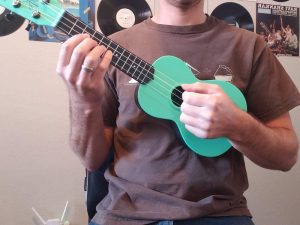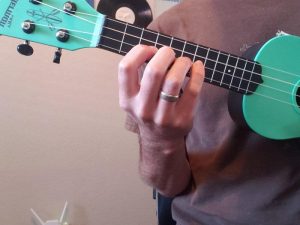Playing ukulele is a fun challenge. The small size of the instrument poses the question of how to hold a ukulele.
In this article, we will explore the best way to hold a ukulele in order to make playing easier and to give you a good foundation to explore playing techniques. We will show how holding a ukulele can help with technique challenges (like barre chords) and give tips on how to maneuver your strumming and fretting hands.
Holding a ukulele is the foundation for your playing. Without a good understanding of how to hold the instrument, you will struggle with certain techniques and it can make playing uncomfortable and frustrating. With a proper hold, you can create leverage and enable good body mechanics to help make playing easier.
How to Hold a Ukulele Body
Let’s start with how to sit in order to have a good hold on the ukulele. Begin with a nice, padded chair that is reasonably low to the ground. You should be able to plant your feet flat on the ground. The chair should have no arms. Scoot to the edge of the chair and sit up but not too rigid – you should find a balance with your hips and lean forward just a bit. Having a nice sitting posture is important for your back and neck health. Remember, you will spend many hours sitting and playing, so a healthy posture for longevity is important. Now you’re ready to pick up your instrument.
The Body Hold
Now pick up your ukulele and bring it up to your chest – it should rest at about the bottom of your sternum. Note: you will not be able to comfortably rest the ukulele on your lap and will have to hold it up with a combination of your arms and hands. Once it is on your chest, angle the head up so that it is roughly parallel with your nose and mouth area.
This is to allow an unbent wrist on your fretting hand: if you held the ukulele more parallel to the floor, then your fretting hand wrist would have to bend too much and not allow for good fretting hand dexterity. After angling the ukulele, take your strumming hand and place it on the strings to rest. Take note of where your forearm rests on the body of the ukulele.
Where your forearm rests on the body of the ukulele, you will now use that point to pin it against your body. Notice how this would make the neck and head flair out – this is good because you can now pull it back with your fretting hand and use that leverage to help you press down the strings, which helps with techniques like barre chords and not squeezing too hard when fretting.
The Fretting Hand
Now let’s talk about your fretting hand. This can be a whole lesson in and of itself, but we’ll give you the basics to get you started. First, hold your fretting hand palm up and touch your fingers to your thumb – as if you were holding an egg. Notice the position of your thumb (in the middle of your fingers and hand) and the angle of the thumb (on its side).
This is the exact position you want to use while playing. Now, place your hand to the ukulele and place the thumb in position behind the neck. Make sure your thumb is in the middle of your hand (around the middle or ring finger) and on its side. Try not to let it show too much above the top of the neck, and keep those fingers curved to meet the strings on the tips.
These tips are meant to guide you as you begin your journey on the ukulele. The foundation of your playing and technique begins with how you hold the instrument. Take these pointers as a starting point and tweak them to make it comfortable for you. The most important points are to be comfortable, make it easier to execute techniques, and create a good sound.
Justin Martinez




